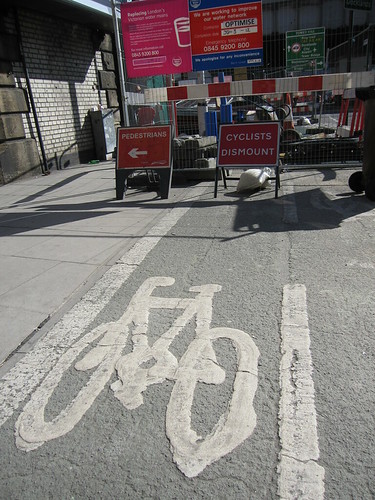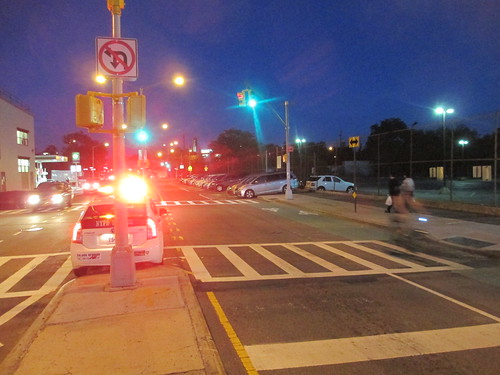Amid the sudden, late onset of a proper winter in New York , I’ve ridden to work far more often than normal
in recent weeks via a longer route over the Brooklyn Bridge Manhattan Bridge ,
cuts down sharply on the amount of time I spend sharing snow-clogged Manhattan cross streets
with irritable, aggressive drivers.
 |
| The Brooklyn Bridge, with cables: New York City corruption, dangling over the East River |
Yet the ride also affords me a chance to ponder a deep and
sometimes under-recognised truth about New
York City . As I cross the bridge, I marvel at the
thickness of the bundle of suspension cables that holds the bridge deck in
place - and remember the story behind them. The bundle is much bigger than the
bridge’s designer, John Roebling, originally intended. Extra, up-to-standard
wire had to be added after Washington Roebling, John’s son, discovered that
corrupt contractors had sneaked large quantities of sub-standard wire into cables
that had already been painstakingly stretched across the East
River . Graft is literally woven into this bit of the city’s
fabric.
Corruption is far from being a mere historic issue, however.
The more one grapples with the challenges facing New York City, the more one
comes up against relationships that powerful people’s pursuit of money or power
have skewed away from working as intended. These pieces of corruption range
from relationships that are straightforwardly crooked, as the relationship
between the bridge builders and the wire contractors was, through a series of
more or less grubby compromises to relationships that seem like a form of
democracy. At that end of the scale there are institutions like the Community
Boards that are meant to protect communities’ interests in planning decisions
but instead end up as the vehicle of noisy vested interests.
 |
| A bike lane built under Janette Sadik-Khan now: the reversal of progress made visible. |
Cyclists are peculiarly aware of this dysfunctionality, I think,
because it is a profoundly conservative force. It seeks to entrench privileges
and works against change. In a city that’s nominally trying to increase its
cycle commuting rate from a modest 1 per cent, that means that many of these
forces are aligned against making life easier for cyclists. If one doesn’t take
into account how these fundamentally regressive relationships shape life in the
city, it’s impossible to understand the near-halting of progress on cycling in
the city since Janette Sadik-Khan, the city’s one-time transport commissioner,
stood down at the end of Michael Bloomberg's time in office in 2013. Without an advocate as forceful and effective as
Sadik-Khan, regressive, conservative, corrupt forces have largely overwhelmed
the continuing faltering efforts under Bill de Blasio towards change.
The scale of the challenge is clear if one thinks carefully
about one of the few pieces of progress to have been made recently – the
decision on February 2 by Manhattan ’s Community
Board 7 to approve installation of a protected bike lane on Amsterdam Avenue on the Upper
West Side . The decision followed years of study and months of
blocking by the co-chairs of the Community Board’s transportation committee. It was passed only after hundreds of advocates turned up at both the February 2
meeting and one in November. If such a vast lobbying effort is required to win
approval for a 38-block (less than two miles) project – one that everyone
except a handful of angry carowners agrees is sensible and needed - it’s
unsurprising that city-wide progress towards building a cycling network looks a distant prospect.
 |
| Your licence to park anywhere: the NYPD placard on an SUV parked unnecessarily in the Hoyt St bike lane. |
My mind started turning to the ubiquity of corruption in New York the night after the CB7 vote, as I rode home
from work through a damp Brooklyn . As I
rounded the corner from Schermerhorn
Street into Hoyt Street in downtown Brooklyn ,
I was forced to brake suddenly on finding two big sports utility vehicles
blocking the narrow street’s bike lane. Knowing that the area was a popular
parking spot for police vehicles from the New York Police Department’s nearby
transit bureau, I suspected these were officers’ private vehicles. Sure enough,
on inspection the dashboards of both vehicles sported NYPD placards that police
officers regard as essentially permission to park illegally wherever they
choose. The following night, another private police vehicle was parked in
exactly the same place. Tweets to the NYPD Transit Bureau about the issue went
unanswered.
The incident reveals a telling type of petty New York City corruption.
Every morning as I battle my way down Jay St in Brooklyn to reach the Manhattan Bridge New York
public life. Loyalty to the interests of one’s group – whether one’s fellow
professionals, members of the same
ethnic group or people who want to defend some other privilege – exerts a far
more powerful force in the city than most of the formal rules meant to govern
it.
I also sometimes encounter on Jay St a red-light sting for cyclists, at
the relatively quiet junction of Jay
St and Concord St. The intersection is the only
point on Jay St
– where there is a daily riot of highly dangerous illegal double-parking,
illegal U-Turns and crosswalk blocking – where I regularly see enforcement
activity. In a city where motorists are still often portrayed as a proxy for
ordinary, working-class New Yorkers, it is far easier for the police to pick on relatively powerless cyclists to make up their monthly ticket totals than to
take the rational course of trying to stamp out the behaviour that does most
damage. Since the police effectively wield far greater power than the mayor,
there is little to stop police officers from engaging in this casual sleight of
hand.
None of this is to say, of course, that corruption both
grave and petty is a uniquely US or New
York phenomenon. When I lived in Budapest ,
I travelled around post-Communist societies far more scarred by corruption than
the US .
It is also clear that New York is far from
being the US ’s
most corruptly-run city. It would seem almost rude to try to displace either Chicago or New
Orleans from their hard-won places at the top of that
league table.
Yet there is a peculiarly New York City combination of factors that
works to overwhelm many positive initiatives, including efforts to promote more
active transport.
Much of the power over the city is exercised by a legislature
150 miles away in Albany
that often seems to view the city as little more than a source of funds. It is
telling that in the recent corruption trial of Sheldon Silver, the former
speaker of the state assembly, the defence’s (ultimately unsuccessful) case was
essentially that the speaker had acted little differently from other members of
the state legislature.
A different version of a similar phenomenon was at work when
a series of members of the New York City Council who had previously been
supportive of safer streets legislation scurried to support amendments that
would effectively have excused bus drivers who killed people. It is no
coincidence, I suspect, that Transport Workers’ Union Local 100, the bus
drivers’ union, is a significant funder of New York political races.
The presence of this mass of interest groups willing to defy
the mayor’s formal authority has long made governing New York City one of the most formidable
tasks in US politics. The Brooklyn
Bridge New York ’s city council – and subsequently, by default,
mayor when the incumbent resigned – simply because he was an Italian from Manhattan . He was needed
to balance out a Democratic slate for top jobs that already had on it an
Irishman from Brooklyn and a Jew from the Bronx .
 |
| London's cycle facilities can also be imperfect, but there is a less pervasive sense of unaccountability |
It is far
easier, it seems to me, to work the levers of power in London ,
where identity politics plays a far smaller role, than in New York Europe have
had far more success in steering through complex transport projects such as
cycling networks and high-quality public transit than southern European
countries with a longer tradition of corruption.
The flipside of
New York City
So far in the
21st century, Sadik-Khan, who will celebrate her achievements in a
new book out on March 8, has proved more adept than most at overcoming the city’s
corrupt conservatism. She closed some of the streets through Times Square, put
bike lanes down Broadway and many other important streets and forced a
badly-needed bike lane down Prospect Park West in Brooklyn .
The Prospect Park West project – over which a handful of rich locals continue
to sue the city – went in over the noisy objections of, among others, the wife
of New York ’s senior US
Yet it is clear
that, while Sadik-Khan did a superb job of forcing through building projects,
she was not able to make activists for cycling and walking a group that New York
 |
| NYPD vehicles block the Broadway bike lane: the lack of explanation is as eloquent as any explanation |
One evening in
early December, I encountered depressing evidence of the fate of groups who
fail to get themselves into a sufficiently strong position in the city’s
pecking order. I rode down the Broadway bike lanes as far as Herald Square Herald Square
There were no
explanations, diversion signs or notices to alert cyclists to the change. The
closure appeared to be a result of an entirely arbitrary police decision that cyclists
could no longer use the route built for them only a few years ago. But, as I
gazed at the police vehicles parked sullenly across my path, that almost seemed
to be part of the point.
“We can do this
to you whenever we want,” they seemed to be saying. “Now what are you going to
do about it?”







